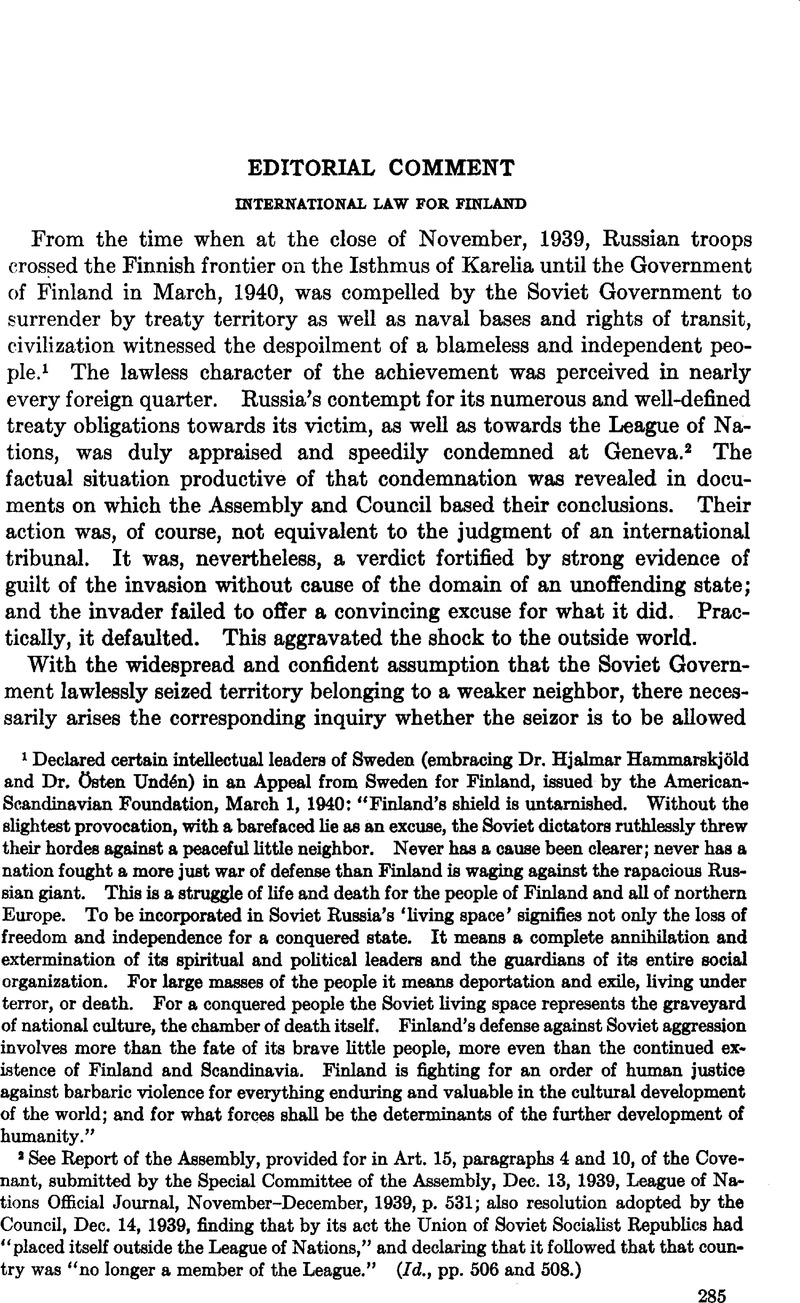Published online by Cambridge University Press: 12 April 2017

1 Declared certain intellectual leaders of Sweden (embracing Dr. Hjalmar Hammarskjöld and Dr. Östen Undén) in an Appeal from Sweden for Finland, issued by the American-Scandinavian Foundation, March 1, 1940: “Finland’s shield is untarnished. Without the slightest provocation, with a barefaced lie as an excuse, the Soviet dictators ruthlessly threw their hordes against a peaceful little neighbor. Never has a cause been clearer; never has a nation fought a more just war of defense than Finland is waging against the rapacious Russian giant. This is a struggle of life and death for the people of Finland and all of northern Europe. To be incorporated in Soviet Russia’s ‘living space’ signifies not only the loss of freedom and independence for a conquered state. It means a complete annihilation and extermination of its spiritual and political leaders and the guardians of its entire social organization. For large masses of the people it means deportation and exile, living under terror, or death. For a conquered people the Soviet living space represents the graveyard of national culture, the chamber of death itself. Finland’s defense against Soviet aggression involves more than the fate of its brave little people, more even than the continued existence of Finland and Scandinavia. Finland is fighting for an order of human justice against barbaric violence for everything enduring and valuable in the cultural development of the world; and for what forces shall be the determinants of the further development of humanity.”
2 See Report of the Assembly, provided for in Art. 15, paragraphs 4 and 10, of the Covenant, submitted by the Special Committee of the Assembly, Dec. 13, 1939, League of Nations Official Journal, November-December, 1939, p. 531; also resolution adopted by the Council, Dec. 14, 1939, finding that by its act the Union of Soviet Socialist Republics had “placed itself outside the League of Nations,” and declaring that it followed that that country was “no longer a member of the League.” (Id., pp. 506 and 508.)
3 For an unofficial text of the Russo-Finnish agreement from the United Press, see New York Times, March 13, 1940, p. 2.
4 Accordingly, it is believed that, in such a case, either party to the arrangement may set up invalidity as an excuse for non-performance, and that, regardless of whether the perfecting of the agreement was due to compulsion.
5 It is unnecessary to marshal the numerous instances where outside states have maintained that no accord between the contracting parties could, without the consent of the former, diminish their legal rights.
6 See “Conquest Today,” by this writer, this Journal, Vol. 30 (1936), p. 471.
7 It will be recalled that in 1933 the American Republics through Art. 11 of the Convention on Rights and Duties of States, concluded at the Seventh International Conference of American States, made the following declaration: “The contracting states definitely establish as the rule of their conduct the precise obligation not to recognize territorial acquisitions or special advantages which have been obtained by force whether this consists in the employment of arms, in threatening diplomatic representations, or in any other effective coercive measure. The territory of a state is inviolable and may not be the object of military occupation nor of other measures of force imposed by another state directly or indirectly or for any motive whatever even temporarily.” (United States Treaties, Vol. IV, p. 4809.)
Again, by Art. 1 of the Treaty for the Fulfillment of Existing Treaties between the American States (United States Treaties, Vol. IV, pp. 4831, 4833), it was declared that as between the contracting states “they will not recognize any territorial arrangement not obtained by pacific means, nor the validity of the occupation or acquisition of territories brought about by force of arms.”
See also the declaration of Mr. Stimson, Secy, of State, Jan. 7, 1932, in the course of the Sino-Japanese conflict in Manchuria, Dept, of State Press Releases, Jan. 9, 1932; this Journal, Vol. 26 (1932), p. 342.
8 According to the Report of the Assembly of the League of Nations of Dec. 13,1939: “The Treaty of Peace signed at Dorpat on October 14, 1920, between Finland and the Russian Socialist Federal Soviet Republic recalls in its preamble that in 1917 Finland was proclaimed an independent state and that Russia had recognized the independence and sovereignty of the Finnish State within the frontiers of the Grand-Duchy of Finland. This treaty fixes, inter alia, the frontier ‘between the States of Russia and Finland, ’ the limit of the territorial waters of the contracting Powers, the military neutralization of certain Finnish islands in the Gulf of Finland, etc.” (League of Nations Official Journal, November-December, 1939, p. 536.) See also, Graham, M. W., The Diplomatic Recognition of the Border States, Part 1, Finland (University of California Press, 1935)Google Scholar, Chap. II.
9 See Report of the Assembly, cited above, League of Nations Official Journal, November-December, 1939, pp. 536–538.
10 See Dept, of State Bulletin, Dec. 2, 1939, p. 610.